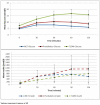The relative associations of β-cell function and insulin sensitivity with glycemic status and incident glycemic progression in migrant Asian Indians in the United States: the MASALA study
- PMID: 24211090
- PMCID: PMC3877179
- DOI: 10.1016/j.jdiacomp.2013.10.002
The relative associations of β-cell function and insulin sensitivity with glycemic status and incident glycemic progression in migrant Asian Indians in the United States: the MASALA study
Abstract
Aims: We assessed the relative associations of β-cell dysfunction and insulin sensitivity with baseline glycemic status and incident glycemic progression among Asian Indians in the United States.
Methods: A 5-sample oral glucose tolerance test was obtained at baseline. Normoglycemia, impaired fasting glucose (IFG), impaired glucose tolerance (IGT), and type 2 diabetes (T2DM) were defined by ADA criteria. The Matsuda Index (ISIM) estimated insulin sensitivity, and the Disposition Index (DIo) estimated β-cell function. Visceral fat was measured by abdominal CT. After 2.5years, participants underwent a 2-sample oral glucose tolerance test. Standardized polytomous logistic regression was used to examine associations with prevalent and incident glycemia.
Results: Mean age was 57±8years and BMI 26.1±4.6kg/m(2). Log ISIM and log DIo were associated with prediabetes and T2DM after adjusting for age, sex, BMI, family history of diabetes, hypertension, and smoking. After adjusting for visceral fat, only DIo remained associated with prediabetes (OR per SD 0.17, 95% CI: 0.70, 0.41) and T2DM (OR 0.003, 95% CI: 0.0001, 0.03). Incidence rates (per 1,000 person-years) were: normoglycemia to IGT: 82.0, 95% CI (40, 150); to IFG: 8.4, 95% CI (0, 41); to T2DM: 8.6, 95% CI (0, 42); IGT to T2DM: 55.0, 95% CI (17, 132); IFG to T2DM: 64.0, 95% CI (3, 316). The interaction between sex and the change in waist circumference (OR 1.8, per SD 95% CI: 1.22, 2.70) and the change in log HOMA-β (OR 0.37, per SD 95% CI: 0.17, 0.81) were associated with glycemic progression.
Conclusions: The association of DIo with baseline glycemia after accounting for visceral fat as well as the association of the change in log HOMA-β with incident glycemic progression implies innate β-cell susceptibility in Asian Indians for glucose intolerance or dysglycemia.
Keywords: Asian Indians; Ethnicity; Impaired fasting glucose; Impaired glucose tolerance; Incidence; Insulin sensitivity; Type 2 diabetes mellitus; β-cell dysfunction.
© 2013.
Figures
Similar articles
-
Associations of β-cell function and insulin resistance with youth-onset type 2 diabetes and prediabetes among Asian Indians.Diabetes Technol Ther. 2013 Apr;15(4):315-22. doi: 10.1089/dia.2012.0259. Epub 2013 Mar 13. Diabetes Technol Ther. 2013. PMID: 23484483
-
Evidence of reduced β-cell function in Asian Indians with mild dysglycemia.Diabetes Care. 2013 Sep;36(9):2772-8. doi: 10.2337/dc12-2290. Epub 2013 Apr 17. Diabetes Care. 2013. PMID: 23596180 Free PMC article.
-
Incidence of diabetes and prediabetes and predictors of glycemic change among South Asians in the USA: the MASALA study.BMJ Open Diabetes Res Care. 2020 Jul;8(1):e001063. doi: 10.1136/bmjdrc-2019-001063. BMJ Open Diabetes Res Care. 2020. PMID: 32646924 Free PMC article.
-
Development of type 2 diabetes mellitus in people with intermediate hyperglycaemia.Cochrane Database Syst Rev. 2018 Oct 29;10(10):CD012661. doi: 10.1002/14651858.CD012661.pub2. Cochrane Database Syst Rev. 2018. PMID: 30371961 Free PMC article.
-
Prevalence of Pre-Diabetes across Ethnicities: A Review of Impaired Fasting Glucose (IFG) and Impaired Glucose Tolerance (IGT) for Classification of Dysglycaemia.Nutrients. 2017 Nov 22;9(11):1273. doi: 10.3390/nu9111273. Nutrients. 2017. PMID: 29165385 Free PMC article. Review.
Cited by
-
Lifestyle and the Prevention of Type 2 Diabetes: A Status Report.Am J Lifestyle Med. 2015 Nov 24;12(1):4-20. doi: 10.1177/1559827615619159. eCollection 2018 Jan-Feb. Am J Lifestyle Med. 2015. PMID: 30202378 Free PMC article. Review.
-
Are excess carbohydrates the main link to diabetes & its complications in Asians?Indian J Med Res. 2018 Nov;148(5):531-538. doi: 10.4103/ijmr.IJMR_1698_18. Indian J Med Res. 2018. PMID: 30666980 Free PMC article. Review.
-
Diabetes Among Non-Overweight Individuals: an Emerging Public Health Challenge.Curr Diab Rep. 2018 Jul 4;18(8):60. doi: 10.1007/s11892-018-1017-1. Curr Diab Rep. 2018. PMID: 29974263 Review.
-
Changes in β-Cell Function in Offspring of Type-2 Diabetic Patients, as per Fasting and Two-Hour Plasma Glucose Levels.Cureus. 2021 May 16;13(5):e15056. doi: 10.7759/cureus.15056. Cureus. 2021. PMID: 34017668 Free PMC article.
-
Cardiometabolic risk factors in young Indian men and their association with parameters of insulin resistance and beta-cell function.World J Cardiol. 2022 Aug 26;14(8):462-472. doi: 10.4330/wjc.v14.i8.462. World J Cardiol. 2022. PMID: 36160812 Free PMC article.
References
-
- Saad MF, Knowler WC, Pettitt DJ, Nelson RG, Charles MA, Bennett PH. A two-step model for development of non-insulin-dependent diabetes. Am. J. Med. 1991;90(2):229–35. - PubMed
-
- Kahn SE. The relative contributions of insulin resistance and beta-cell dysfunction to the pathophysiology of Type 2 diabetes. Diabetologia. 2003;46(1):3–19. - PubMed
-
- Gastaldelli A, Ferrannini E, Miyazaki Y, Matsuda M, DeFronzo RA. Beta-cell dysfunction and glucose intolerance: results from the San Antonio metabolism (SAM) study. Diabetologia. 2004;47(1):31–9. - PubMed
-
- Florez JC. Newly identified loci highlight beta cell dysfunction as a key cause of type 2 diabetes: where are the insulin resistance genes? Diabetologia. 2008;51(7):1100–10. - PubMed
Publication types
MeSH terms
Substances
Grants and funding
LinkOut - more resources
Full Text Sources
Other Literature Sources
Medical
Research Materials


